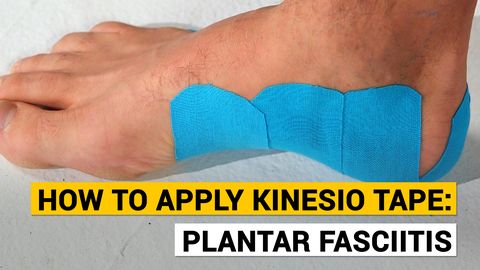
Photo Source: runnersworld.com
There are lots of treatments for plantar fasciitis, but one that is often overlooked is kinesiology tape. Kinesiology tape can be a great tool to help relieve pain and promote healing. In this article, we will show you how to use kinesiology tape for plantar fasciitis. Also, we will provide a complete guide on what kinesiology tape is, how it works, and when to use it.
What Is Kinesiology Tape?

Photo Source: youtube.com
Kinesiology tape is a type of adhesive tape that is used to support muscles, tendons, and ligaments. It is often used by athletes to prevent injuries and help with recovery. The tape is made of stretchy material that allows it to move with your body. It is also designed to be waterproof so that it can be worn during exercise or in the shower. Kinesiology tape works by providing support to muscles and tendons. It can also help to reduce pain and inflammation. The tape is applied to the skin and then pulled tight. This creates a lifting effect that helps to support the muscles and tendons underneath.
Kinesiology tape can be used to treat a variety of injuries, including plantar fasciitis. The tape can be applied before or after exercise. It is important to note that the tape should not be worn for more than 5 days in a row. You should also avoid applying the tape to any area that is injured or irritated.
Steps On How to Use A Kinesiology Tape For Plantar Fasciitis

Photo Source: verywellhealth.com
To properly use kinesiology tape for plantar fasciitis, follow these steps:
1. Clean the area where you will be applying the tape
Start by cleaning the area of your foot where you will be applying the tape. This will help to ensure that the tape sticks well and does not cause any irritation. You can use mild soap and water to clean the skin. Be sure to dry the area completely before applying the tape.
2. Cut the kinesiology tape
Next, you will need to cut the kinesiology tape to the desired length. It is important to make sure that the tape is not too tight or too loose. If it is too tight, it may cause pain or irritation. If it is too loose, it will not provide adequate support.
3. Apply the tape
Now, you are ready to apply the tape. Start by peeling off the backing of the tape. Then, apply the tape to the skin with the adhesive side down. Be sure to smooth out any bubbles or wrinkles. Once the tape is in place, you can gently pull on both ends to remove any slack.
4. Wear the kinesiology tape for 24 hours
You can leave the kinesiology tape in place for up to 24 hours. After that, you will need to remove the tape and clean the area. You can reapply the tape as needed. However, it is important to give your skin a break from the tape every few days.
5. Remove the tape
To remove the tape, start by gently peeling it off at one end. Then, slowly roll it off of the skin. If you experience any pain or irritation, stop and consult a healthcare professional.
Additional Tips When Using A Kinesiology Tape For Plantar Fasciitis

Photo Source: performancehealthacademy.com
Here are some tips to help you get the most out of using a kinesiology tape for plantar fasciitis:
- Apply the tape before bedtime so that you can sleep with it in place. It is preferable to apply the tape in the evening so that you can remove it in the morning.
- Be sure to clean your feet thoroughly before applying the tape. This will help to ensure that the tape sticks well and does not cause any irritation. Also, be sure to dry the area completely before applying the tape.
- Cut the kinesiology tape into strips of different lengths. This will allow you to customize the support that you need. However, be sure to cut the strips so that they are not too tight or too loose.
- Apply the kinesiology tape over a layer of lotion or cream. This will help to reduce friction and make it easier to remove the tape.
- Avoid using kinesiology tape on broken skin. If you have any cuts or scrapes, be sure to cover them with a bandage before applying the tape.
- Use scissors to round off the corners of the kinesiology tape. This will help to prevent the tape from peeling off prematurely.
- If you are using the tape for a recent injury, it is important to consult a healthcare professional before applying the tape. This will help to ensure that you are using the tape correctly and not causing any further damage.
Conclusion
Kinesiology tape is a versatile tool that can be used to treat a variety of injuries, including plantar fasciitis. To make the most of it, follow the instructions above. With proper application, the tape can provide much-needed relief from the pain of plantar fasciitis. Additionally, be sure to consult a healthcare professional if you have any concerns about using kinesiology tape.

